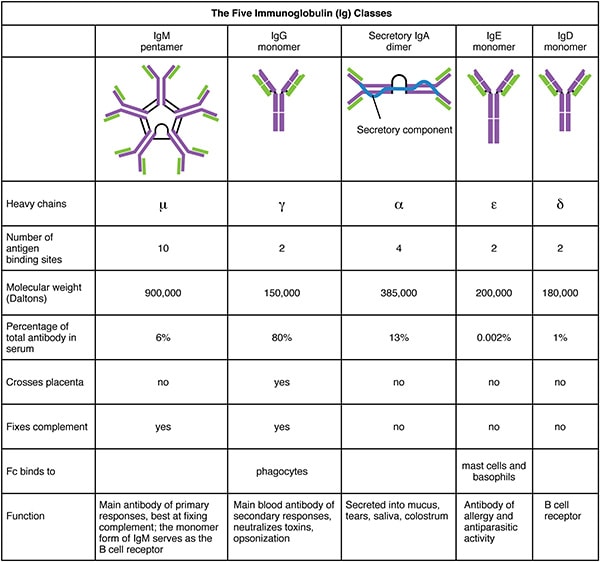Antibodies, also called Ac or immunoglobulins (Ig), are proteins produced by the immune system in response to an invading agent in the body, be it an infectious agent, tumor cell or substance capable of triggering an allergic response.
Antibodies have a Y shape, being biochemically constituted by light and heavy chains formed by amino acids and which are linked by disulfide bonds.
According to the amount of bridges (chemical bonds) present, it is possible to classify the antibodies into some types, which may be present in mucous membranes, be transmitted during breastfeeding or during pregnancy, or be produced as a consequence of allergenic or infectious stimuli.
Antibody function
Antibodies have as their main function to protect the body against invading agents, whether they are microorganisms, tumor cells or substances capable of triggering an allergic response. For this, antibodies can perform their activity in three different ways:
- Neutralization, in which antibodies prevent the entry of the infectious agent into cells, preventing the development of disease;
- Opsonization, in which antibodies coat the invading agent and stimulate macrophages in order to eliminate the foreign body;
- Lyse, that antibodies promote the direct destruction of the invading agent through the activation of alternative pathways of pathogen destruction.
In this way, antibodies play an essential role in immunity and in fighting disease.
How are antibodies formed
Antibodies are proteins produced by B lymphocytes after the identification of the foreign agent, which can happen during an infection or pregnancy, in which the baby’s organism, when coming into contact with the mother’s organism, starts to produce antibodies. Thus, as soon as the presence of a foreign body is noticed, the B lymphocytes coordinate the production of antibodies in order to inhibit the multiplication and/or the activity of toxins produced by the invading agent, for example, protecting the organism.
In addition, some vaccines are produced with the virus inactive or attenuated, so that it is possible to stimulate an immune response and lead to the production of antibodies by B lymphocytes. Another way to obtain antibodies is through breastfeeding, in which antibodies are present. in the maternal circulation they are transmitted to the baby.
Depending on how the antibodies are obtained, it is possible to classify immunization into two main groups: active immunization, which happens naturally, or passive immunization, which happens artificially, as is the case with vaccines. Learn about types of immunizations and how the immune system works.
COVID-19 Antibodies
Antibodies to COVID-19 can be produced after infection or acquired through immunization. Thus, when measuring antibodies, especially IgG or IgM, it is possible to know whether the person is infected or not and, if so, whether it corresponds to a recent or past infection.
In general, in the case of COVID-19, the levels of IgM and IgG start to increase as soon as the infection occurs, however, the levels start to be detected in the exam from the 7th day of infection and the maximum peak of sensitivity it is between day 14 and 21, after the onset of clinical manifestations. Then, 1 to 2 months after SARS-CoV-2 infection, it is possible to notice a decrease in the concentration of IgM for COVID-19, while IgG remains high. See more about IgG and IgM.
Types of antibodies
According to the structural characteristics, function and location in which they are present, antibodies, also called immunoglobulins or Ig, can be classified into some types, the main ones being:
| Immunoglobulins | Characteristics |
|---|---|
| Iga | It protects the intestine, respiratory and urogenital tracts from infections and can be obtained through breastfeeding, in which the antibody is transmitted from mother to baby |
| IgD | It is expressed together with IgM during the acute phase of infections, however its function is still unclear |
| Ige | It is expressed during allergic reactions |
| IgM | It is produced in the acute phase of infection and is responsible for activating the complement system, which is a system formed by proteins responsible for facilitating the elimination of the invading microorganism |
| IG G | It is the most common type of antibody in plasma, it is considered the memory antibody and it protects the newborn, as it can cross the placental barrier |
In addition, there are autoantibodies, which are those produced by the immune system and which act against proteins produced by the organism itself, and their presence is mainly observed in the case of autoimmune diseases.
Neutralizing Antibodies
A neutralizing antibody is one that acts on a part of the infectious agent, for example, neutralizing its activity. For example, in the case of COVID-19, for an infection to exist, the protein present on the surface of the virus must come into contact with the surface of human cells. Thus, to prevent infection from occurring, the neutralizing antibody can act directly on the viral surface protein, preventing the entry of the virus into the cell and the development of infection.
monoclonal antibodies
Monoclonal antibodies are laboratory-produced antibodies specific to only a specific region of the antigen, acting more specifically and fighting the antigen more effectively. Monoclonal antibodies can be used extensively in the diagnosis of diseases or treatment, being one of the treatment options considered for cancer. Learn more about monoclonal antibodies.
What is the difference between antigen and antibody?
Although antigens and antibodies are part of the immune response, they are proteins with different origins and functions. Antigens are proteins present on the surface of microorganisms, while antibodies are proteins that are produced in response to the infectious agent.
Thus, in the presence of an invading agent, the immune system performs the recognition of this agent through the antigens, and then, the production of specific defense proteins against that infectious agent, the antibodies, is coordinated.
